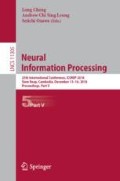Abstract
Underwater man-made object recognition in optical images plays important roles in both image processing and oceanic engineering. Deep learning methods have received impressive performances in many recognition tasks in in-air images, however, they will be limited in the proposed task since it is tough to collect and annotate sufficient data to train the networks. Considered that large-scale in-air images of man-made objects are much easier to acquire in the applications, one can train a network on in-air images and directly applying it on underwater images. However, the distribution mismatch between in-air and underwater images will lead to a significant performance drop. In this work, we propose an end-to-end weakly-supervised framework to recognize underwater man-made objects with large-scale labeled in-air images and sparsely labeled underwater images. And a novel two-level feature alignment approach, is introduced to a typical deep domain adaptation network, in order to tackle the domain shift between data generated from two modalities. We test our methods on our newly simulated datasets containing two image domains, and achieve an improvement of approximately 10 to 20 % points in average accuracy compared to the best-performing baselines.
The work is supported in part by National Natural Science Foundation of China under grants of 81671766, 61571382, 61571005, 81301278, 61172179 and 61103121, in part by Natural Science Foundation of Guangdong Province under grant 2015A030313007, in part by the Fundamental Research Funds for the Central Universities under Grants 2072018005920720160075, in part of the Natural Science Foundation of Fujian Province of China (No. 2017J01126).
Access this chapter
Tax calculation will be finalised at checkout
Purchases are for personal use only
References
Jaffe, J.S.: Underwater optical imaging: the past, the present, and the prospects. IEEE J. Oceanic Eng. 40(3), 683–700 (2015)
Ancuti, C.O., Ancuti, C., De Vleeschouwer, C., Bekaert, P.: Color balance and fusion for underwater image enhancement. IEEE Trans. Image Process. 27(1), 379–393 (2018)
Hussain, S.S., Zaidi, S.S.H.: Underwater man-made object prediction using line detection technique. In: 2014 6th International Conference on Electronics, Computers and Artificial Intelligence (ECAI), pp. 1–6. IEEE (2014)
Hou, G.-J., Luan, X., Song, D.-L., Ma, X.-Y.: Underwater man-made object recognition on the basis of color and shape features. J. Coast. Res. 32(5), 1135–1141 (2015)
Olmos, A., Trucco, E.: Detecting man-made objects in unconstrained subsea videos. In: BMVC, pp. 1–10 (2002)
Hinton, G.E., Osindero, S., Teh, Y.-W.: A fast learning algorithm for deep belief nets. Neural Comput. 18(7), 1527–1554 (2006)
Pan, S.J., Yang, Q.: A survey on transfer learning. IEEE Trans. Knowl. Data Eng. 22(10), 1345–1359 (2010)
Gong, B., Shi, Y., Sha, F., Grauman, K.: Geodesic flow kernel for unsupervised domain adaptation. In: 2012 IEEE Conference on Computer Vision and Pattern Recognition, pp. 2066–2073. IEEE (2012)
Long, M., Cao, Y., Wang, J., Jordan, M.: Learning transferable features with deep adaptation networks. In: International Conference on Machine Learning, pp. 97–105 (2015)
Nguyen, R.M.H., Kim, S.J., Brown, M.S.: Illuminant aware gamut-based color transfer. In: Computer Graphics Forum. Wiley Online Library, vol. 33, pp. 319–328 (2014)
Schechner, Y.Y., Karpel, N.: Clear underwater vision. In: 2004 IEEE Computer Society Conference on Computer Vision and Pattern Recognition, vol. 1, p. I. IEEE (2003)
Goodfellow, I., et al.: Generative adversarial nets. In: Advances in Neural Information Processing Systems, pp. 2672–2680 (2014)
Ganin, Y., Lempitsky, V.: Unsupervised domain adaptation by backpropagation. In: International Conference on Machine Learning, pp. 1180–1189 (2015)
Long, M., Zhu, H., Wang, J., Jordan, M.I.: Unsupervised domain adaptation with residual transfer networks. In: Advances in Neural Information Processing Systems, pp. 136–144 (2016)
Li, Y., Lu, H., Li, J., Li, X., Li, Y., Serikawa, S.: Underwater image de-scattering and classification by deep neural network. Comput. Electr. Eng. 54, 68–77 (2016)
Ganin, Y., et al.: Domain-adversarial training of neural networks. J. Mach. Learn. Res. 17(1), 1–35 (2016)
Long, M., Zhu, H., Wang, J., Jordan, M.I.: Deep transfer learning with joint adaptation networks. In: International Conference on Machine Learning, pp. 2208–2217 (2017)
Saenko, K., Kulis, B., Fritz, M., Darrell, T.: Adapting visual category models to new domains. In: Daniilidis, K., Maragos, P., Paragios, N. (eds.) ECCV 2010. LNCS, vol. 6314, pp. 213–226. Springer, Heidelberg (2010). https://doi.org/10.1007/978-3-642-15561-1_16
Srividhya, K., Ramya, M.M.: Accurate object recognition in the underwater images using learning algorithms and texture features. Multimedia Tools Appl. 76(24), 25679–25695 (2017)
Pavin, A.: Underwater object recognition in photo images. In: OCEANS 2015, MTS/IEEE Washington, pp. 1–6. IEEE (2015)
Russakovsky, O., et al.: Imagenet large scale visual recognition challenge. Int. J. Comput. Vis. 115(3), 211–252 (2015)
Sun, B., Saenko, K.: Deep CORAL: correlation alignment for deep domain adaptation. In: Hua, G., Jégou, H. (eds.) ECCV 2016. LNCS, vol. 9915, pp. 443–450. Springer, Cham (2016). https://doi.org/10.1007/978-3-319-49409-8_35
Krizhevsky, A., Sutskever, I., Hinton, G.E.: ImageNet classification with deep convolutional neural networks. In: Advances in Neural Information Processing Systems, pp. 1097–1105 (2012)
Author information
Authors and Affiliations
Corresponding author
Editor information
Editors and Affiliations
Rights and permissions
Copyright information
© 2018 Springer Nature Switzerland AG
About this paper
Cite this paper
Chen, C., Xie, W., Huang, Y., Yu, X., Ding, X. (2018). Weakly-Supervised Man-Made Object Recognition in Underwater Optimal Image Through Deep Domain Adaptation. In: Cheng, L., Leung, A., Ozawa, S. (eds) Neural Information Processing. ICONIP 2018. Lecture Notes in Computer Science(), vol 11305. Springer, Cham. https://doi.org/10.1007/978-3-030-04221-9_28
Download citation
DOI: https://doi.org/10.1007/978-3-030-04221-9_28
Published:
Publisher Name: Springer, Cham
Print ISBN: 978-3-030-04220-2
Online ISBN: 978-3-030-04221-9
eBook Packages: Computer ScienceComputer Science (R0)

